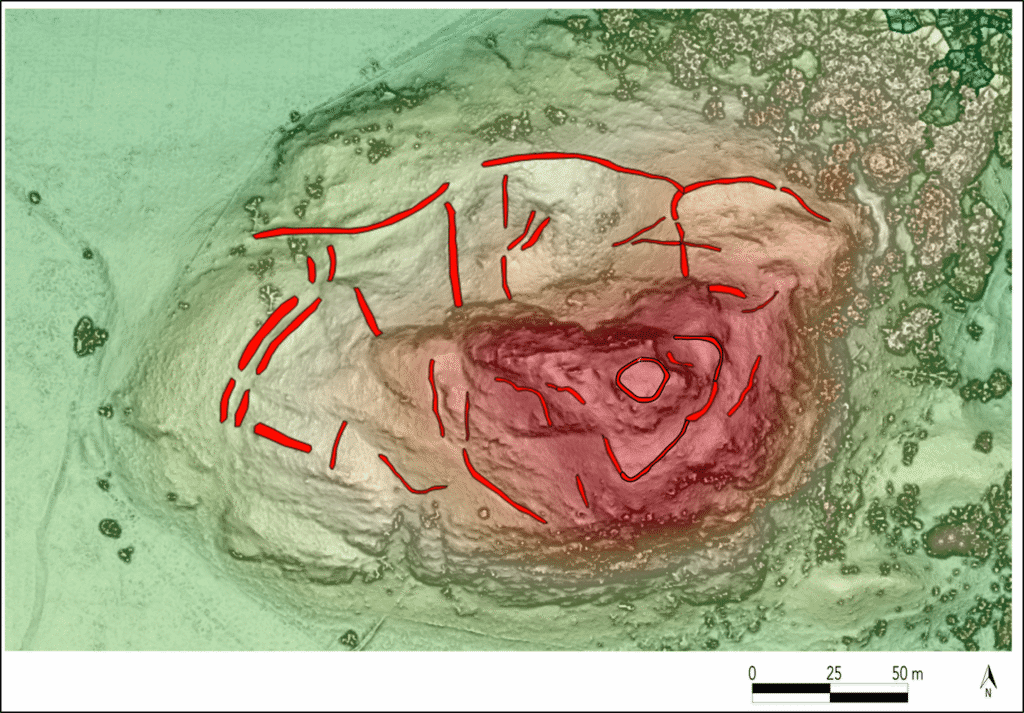Dundurn dendrochronological and radiocarbon analysis
Utilising modern techniques to learn more about early medieval Scotland
A Society grant allowed Professor Gordon Noble FSAScot and Dr Anne Crone FSAScot to redate archive materials from Dundurn, Perthshire, producing the first ever dendro-supported Bayesian modelled dating sequence for early medieval eastern Scotland.

Aerial view of Dundurn hillfort © HES
In early medieval eastern Scotland, Dundurn is one of the few Pictish sites identified in early documents. The Annals of Ulster record a siege here in AD 682 and the Alba king-list refers to Giric son of Dúngal, a late 9th century ruler, dying at Dundurn. Investigations at the hillfort were conducted in 1976-1977 as part of pioneering early medieval scholar Leslie Alcock’s long-term programme of excavating historically documented early medieval fortifications. His programme of work in Scotland began in 1973 and involved ‘keyhole’ excavation at sites that had references in contemporary sources. While Alcock’s work was seminal for early medieval studies in northern Britain, there are now opportunities to produce much more robust chronologies for the important sites he investigated.
At Dundurn, Alcock’s keyhole excavations revealed a prominent summit citadel enclosure with a series of lower enclosures on top of a craggy outcrop overlooking the Earn river. An early palisaded hilltop enclosure appears to have been replaced by multiple phases of a stone-built, timber-laced summit citadel. Evidence of the primary palisade consisted of rock-cut grooves as well as preserved timbers found in waterlogged deposits. These timbers included a number of oak beams and thinner oak planks, some with evidence for wooden peg fasteners. The complex carpentry of this phase is reminiscent of the, recently identified, outer enclosing works of the major early medieval power centre at Rhynie, Aberdeenshire (the subject of a forthcoming Society monograph). The finds and contemporary references from Dundurn suggest this too was a high-status site and one of only a handful of dated early medieval forts known in eastern Scotland.

Photogrammetry-derived model of Dundurn hillfort with the complex defences mapped © University of Aberdeen
There are only six published radiocarbon dates for the entire sequence from Dundurn (Alcock et al 1990). These have wide error margins and in some cases were obtained from mixed samples. A wiggle matched sample provided some extra chronological resolution, but there were opportunities to significantly advance on Alcock’s results using modern methods. The Society grant went towards new radiocarbon dating and dendrochronological sampling.
This new dendrochronological analysis is particularly exciting. The analysis has resulted in the dendro-dating of two timbers from Dundurn and the inclusion of a third timber into a wiggle-match dated chronology. These results all confirm building activity at Dundurn in the early 7th century AD. This is the first advance in the development of an Early Historic tree-ring chronology for nearly two decades and although the results are not extensive, they demonstrate that the tree-ring signal in the cluster of chronologies from south-east Scotland is strong enough to enable the dating of assemblages from further north in Scotland. The radiocarbon dates fall within the determinations of the previous radiocarbon dates but have much smaller error margins and promise to provide a much more accurate overall chronology for the site.
The authors sincerely thank the Society of Antiquaries of Scotland for supporting the important research outlined here. The work promises to provide a robust chronology for a key early medieval site and will set the foundations for dendrochronology of early medieval sites in eastern Scotland.
References
Alcock, L, Alcock, E A and Driscoll, S T 1990 ‘Reconnaissance excavations on Early Historic fortifications and other royal sites in Scotland, 1974-84: 3, Excavations at Dundurn, Strathearn, Perthshire, 1976-77’, Proceedings of the Society of Antiquaries of Scotland 119, 189–226. https://doi.org/10.9750/PSAS.119.189.226

